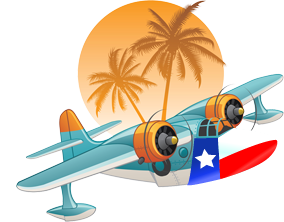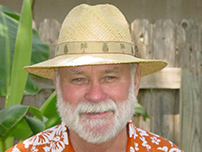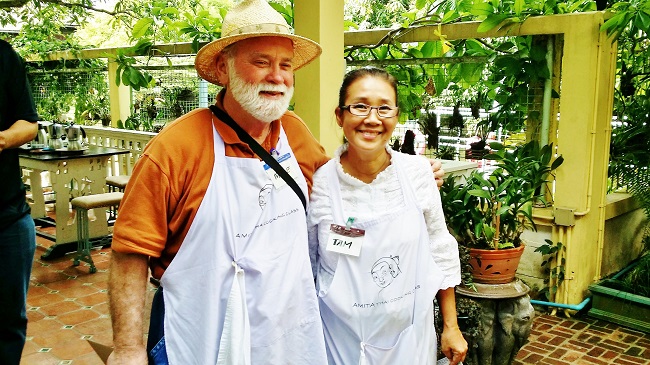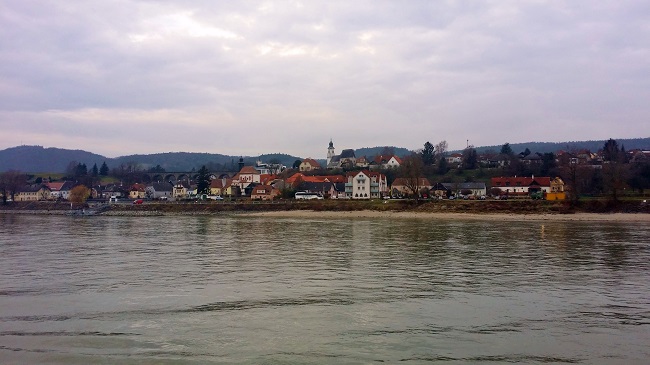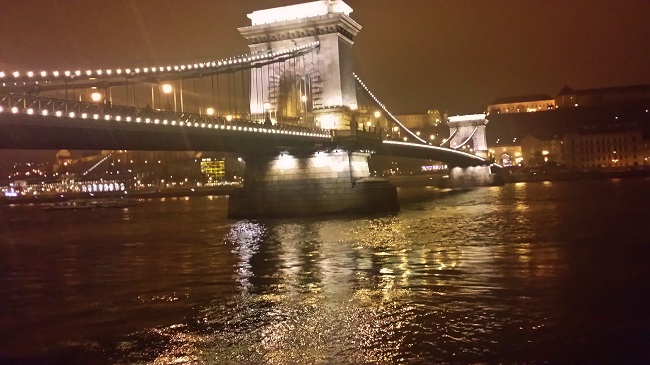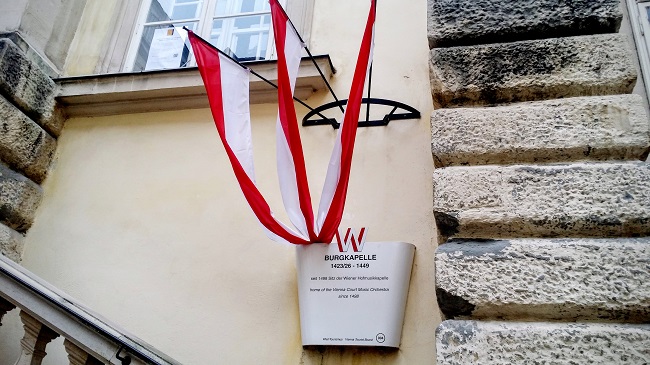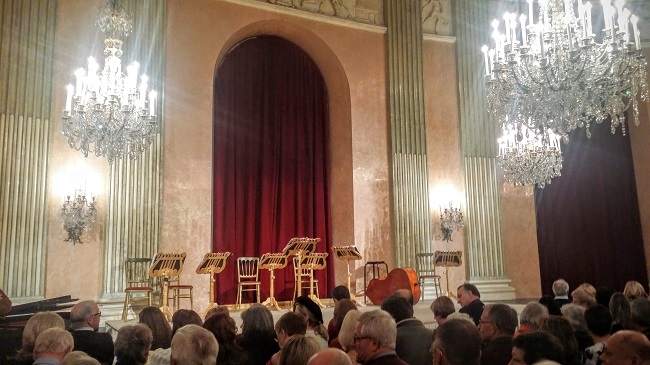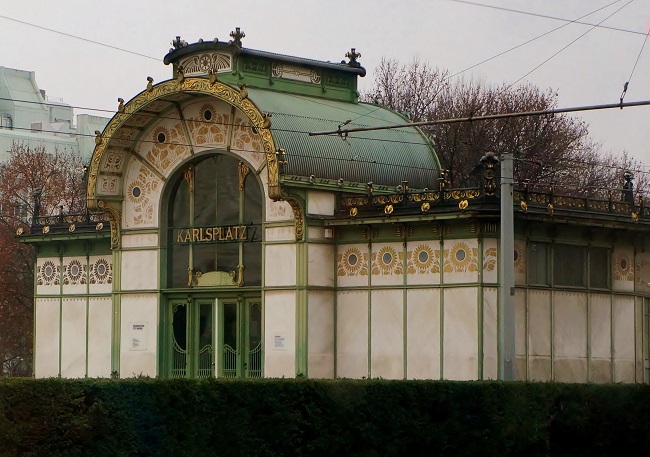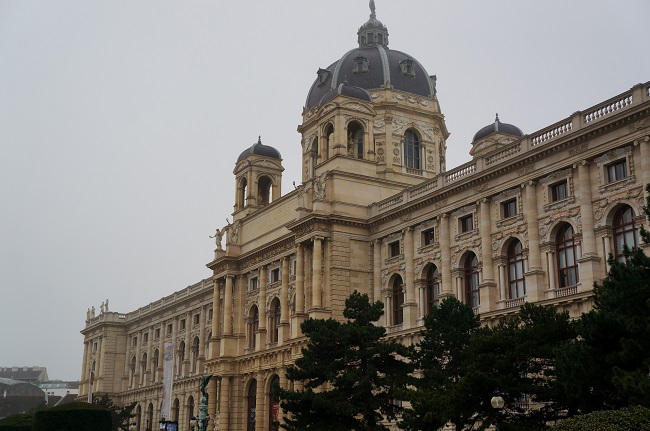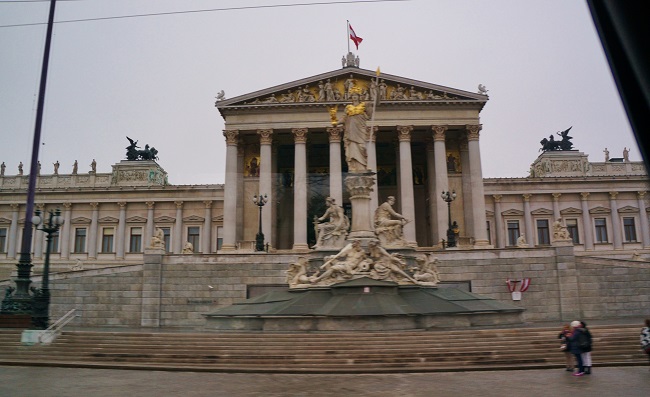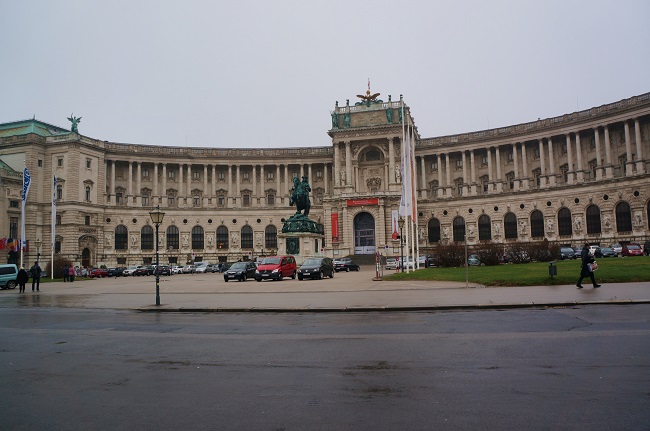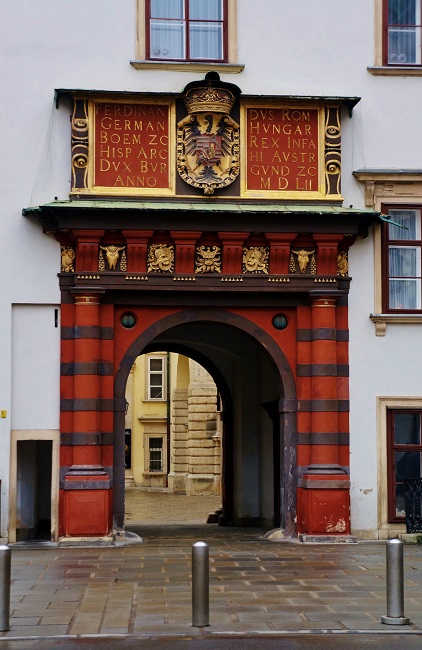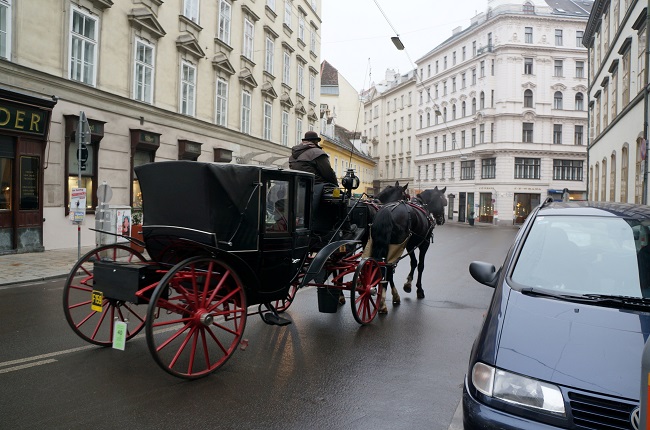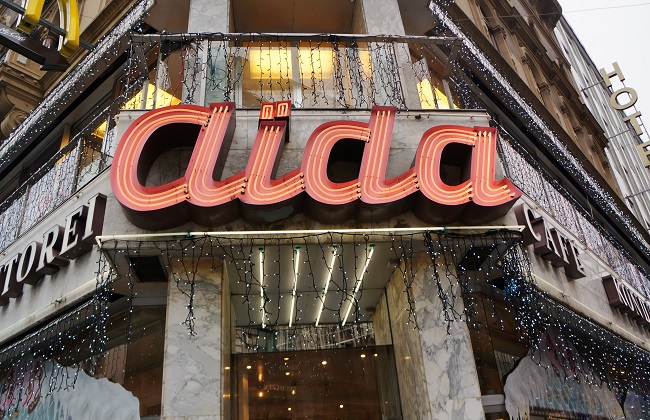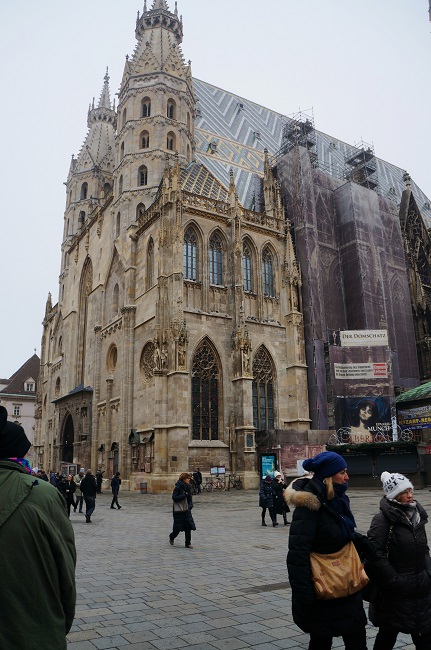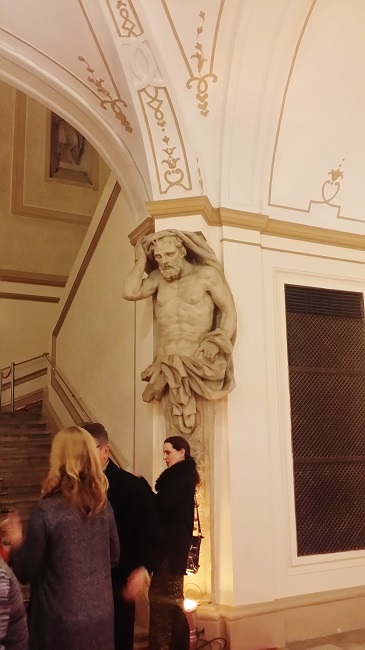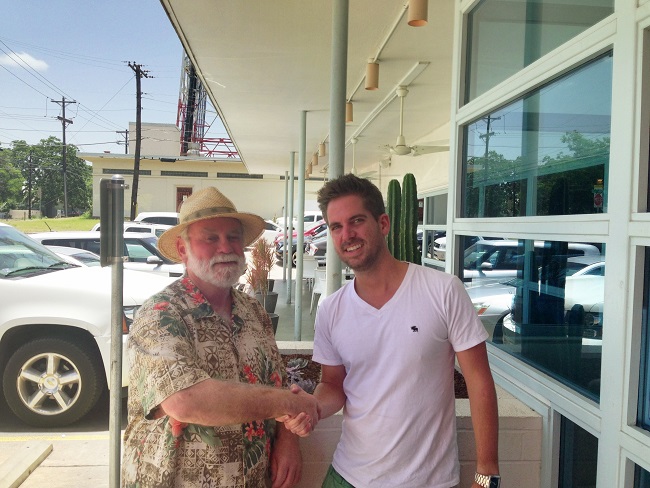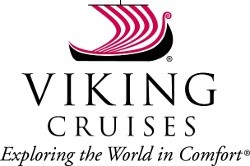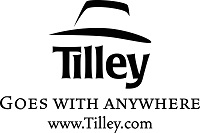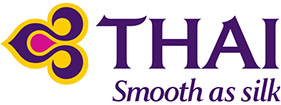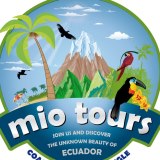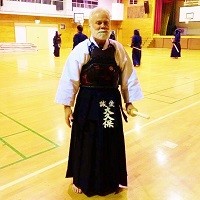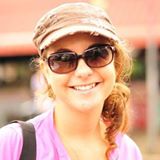Viking Cruises, Heidelberg
We disembarked from the Viking Eir with Viking River Cruises in Mannheim and all boarded a bus for Heidelberg. The journey was very short and after about only 25 minutes we arrived in the city of Heidelberg. The city of approximately 156,000 people is located in Southwest Germany on the Neckar river, which flows into the Rhine river and is basically a university town.
The University of Heidelberg was founded in 1386 and is Germany’s oldest and is one of Europe’s most renowned. Heidelberg the city itself, is home to several internationally esteemed research facilities located adjacent to its university, among them are the European Molecular Biology Laboratory and Molecular Biology Organization, the German Cancer Research Center and four four Max Planck Institutes including the Institute for Medical Research, Astronomy, Nuclear Physics and Comparative Public Law and International Law.

Viking Tour Bus
Heidelberg can be traced back to the fifth century, but its first written reference was in 1155. It is known as the romantic popular tourist destination due to its romantic cityscape, including Baroque style architecture, especially in “Old Town”. The city has so much to offer: charm and character in abundance between the Old Bridge and the mighty castle, an unparalleled choice of culture and entertainment, generous yet heavenly cuisine and a picturesque setting nestled between the Neckar river and the foothills of the Odenwald forest. The 1925 song “I Lost My Heart in Heidelberg” composed by Fred Raymond was a major hit and inspired a stage musical and two films. It remains the theme song of Heidelberg.
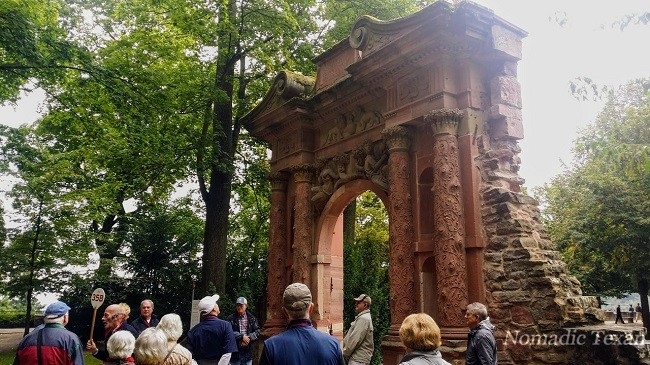
Heidelberg Castle Entry Arch
Our first stop was Heidelberg Castle, a ruin in Germany and one of the most important Renaissance structures north of the Alps. The main structure was erected in 1214 and expanded into two castles in around 1294. In 1537 a lightening-bolt ruined the upper castle. In 1764, another lightning-bolt caused a fire which destroyed some of the rebuilt sections. The castle was partially rebuilt in the 17th and 18th centuries after wars and fires damaged several portions of the castle. Once you pass through the entry arch you start to view the ruins and damage that the years have done to the castle. The area also presents magnificent photo opportunities, as this was of the dry moat with all the green flora and fauna growing.
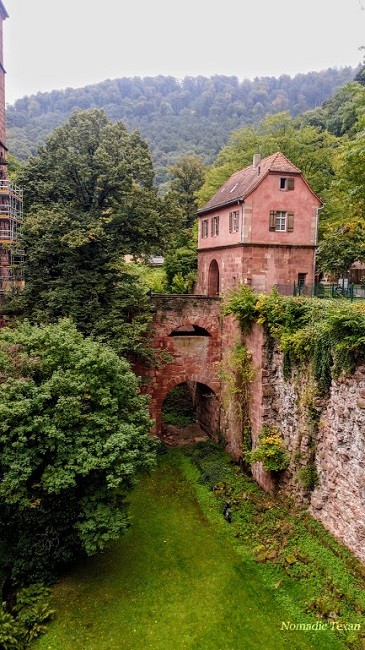
Heidelberg Castle Moat
Of particular interest was this photo of the castle’s ruins with the round tower in the right section. Apparently it was customary in those days to have the toilet just off the dining area, the excrement dropping to be used for fertilizer on the gardens below. Kim toured the Marksburg Fortress the day before and her guide explained the door to the toilet could only be locked from the outside because in the event of an attack the enemy could enter into the “heart” of the castle through the toilet.

Heidelberg Castle Ruins
As you enter the castle and walk through the tunnel you view these iron spokes above. They were lowered if enemy forces were attacking and kept armies at bay, at least temporarily until the castle occupants could prepare. It was actually a little nerve wracking to walk under the spikes. I was glad we didn’t suffer an earthquake and have them dislodged accidentaly.

Heidelberg Castle Gate Guard
Once inside the castle you come upon walls and walls of intricate manifestations filled with Baroque style art and sculptures of the various period emperors, princes and kings. One cannot imagine the detail that went into these facades. Sculptures of the former German kings and emperors of the Holy Roman Empire that adorn the facade are one of the earliest examples of German Renaissance architecture and are gorgeous in appearance.
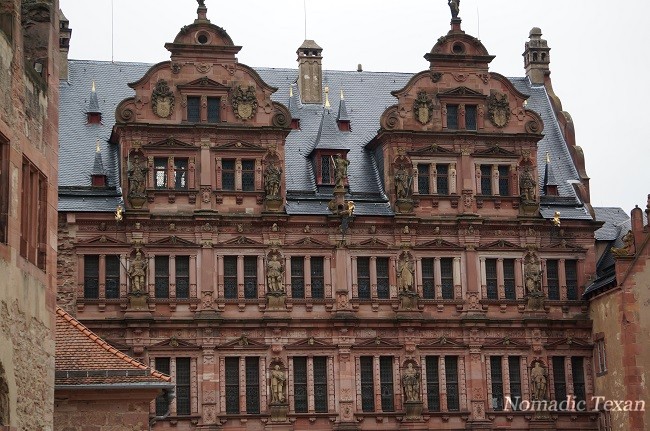
Statues on the Facade of Schloss Heidelberg in Heidelberg, Baden-Württemberg, Germany
The German Museum of Pharmacy Foundation was established in 1937 and the museum itself opened in 1938 in Munich and was closed down during World War II. In 1957, the German Museum of Pharmacy was officially reopened in Heidelberg Castle where it offers striking views of the most complete collection of items worldwide, highlighting the history of pharmacy on a maximum quality level to hundreds of thousands of visitors every year. The museum is home to over 20,000 objects displaying a trip through the history of medical science, especially focused on the progression of pharmacology as first nearly a magic art, then a science.
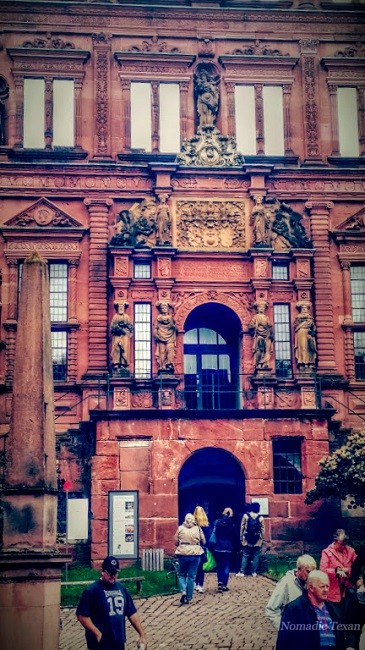
Heidelberg Castle Pharmacy Museum Entrance
Berthold, our Viking guide was humorous and very knowledgeable of the history of Heidelberg Castle. One of his points of interest was this “tree of love” where several young lovers over the years would meet and extend their arms through the gap in the base trunk and large limb to secretly hold hands. As any close contact was forbidden at this time, it was a way of showing your love to your special person and being able to hide your contact from the public.
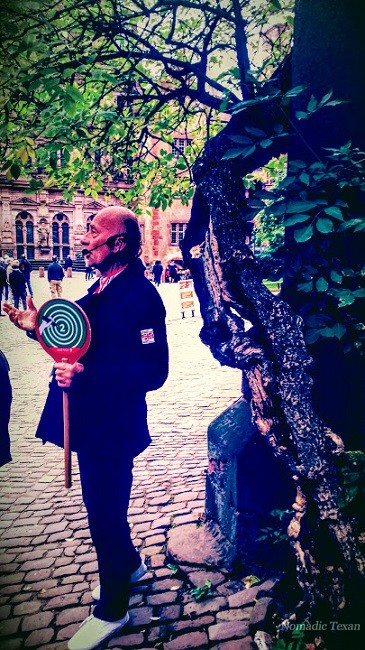
Heidelberg Castle Viking Guide Tree of Love
These statues on the side of the castle tower portrayed the Dicker Turm, Thick Tower or Fat Tower adjoining the English wing and Featuring two Palatine Electors (Counts), Ludwig V (von der Pfalz) on the left and Friederich V (von der Pfalz) on the right, who built this section of the Schloss Heidelberger (Heidelberg Castle).
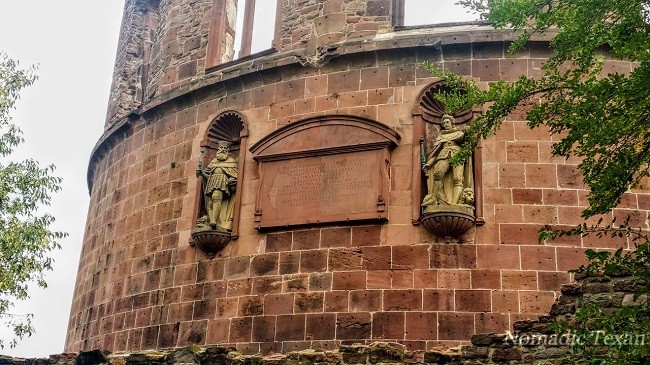
Heidelberg Castle Ludwig V and Friederich V
This villa (Heinertowner) is located on the hill adjacent to the castle and clearly visible from the valley overlook of the castle. It is reportedly a student house for the University of Heidelberg. My apologies, but I was not able to conform this. It was a lovely structure and I decided to photograph it with my new 80-200 zoom lens.

Heidelberg University Student Housing
Heidelberg Castle is located on the Konigstuhl hillside and served by the Heidelberger Bergbahn funicular railway that runs from Heidelberg’s Kornmarkt (grain market) to the summit of the Königstuhl (1,863 ft high hill in the Odenwald Mountains). The castle is located approximately 250 feet up the mountain. The castle overlooks the beautiful Baroque “Old Town” and one can see for miles down the Neckar valley, all the way to Mannheim where we disembarked from our Viking Longship.
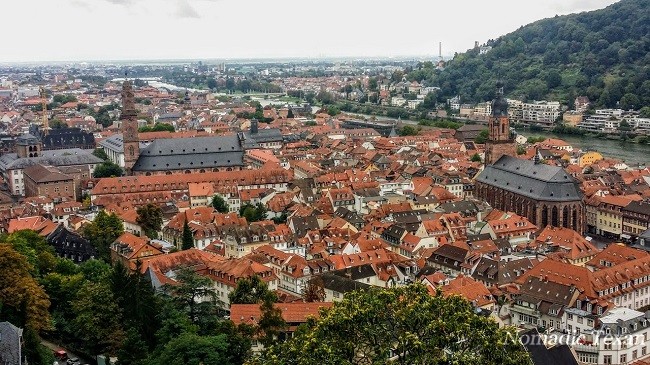
View from Heidelberg Castle
Another view from the castle overlook is the The Karl Theodor Bridge, commonly known as the Old Bridge, is a stone bridge in Heidelberg, crossing the Neckar River. It connects the Old City with the eastern part of the Neuenheim district of the city on the opposite bank. The current bridge, made of Neckar Valley Sandstone and the ninth built on the site, was constructed in 1788 by Elector Charles Theodore and is one of the best-known and amazing landmarks and tourist destinations in the history of Heidelberg.
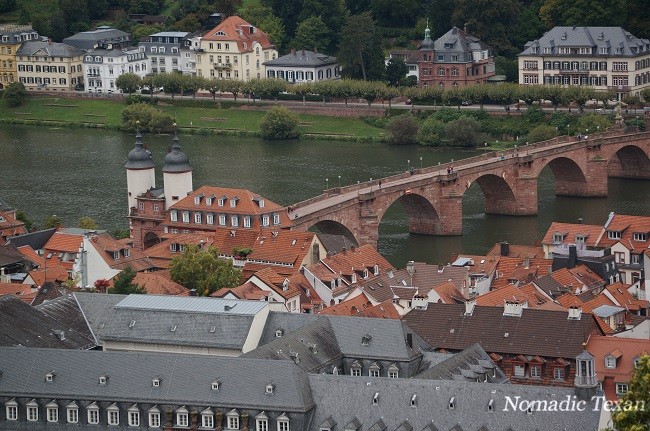
The Karl Theodor Bridge or Old Bridge,
After going out on the overlook, which is a magnificent place for photos, especially panoramas, we then strolled through the courtyard and came upon this Sundial that was in use hundreds of years ago and according to Berthold our Viking guide, the sundial is more accurate than most clocks.

The Courtyard Sundial in Heidelberg Castle
I am sad that my photos of the world’s largest wine-cask, didn’t turn out. It is named the “Heidelberg Tun” and holds approximately 219,000 liters of wine or 58,574 US gallons. One hundred and thirty oak trees were sacrificed for this barrel. The vat is credited in several novels including “Five Weeks in a Balloon” by Jules Verne, “Les Miserables” by Victor Hugo, “Moby-Dick” by Herman Melville and “A Tramp Abroad” by Mark Twain. It is located underneath the castle.
Perkeo of Heidelberg (born Clemens Pankert) was a jester and court dwarf for Palatine Charles III Philip in Heidelberg. He was originally a button maker in Salorno Italy, South Tyrol. In about 1718 Perkeo met Prince Charles III Philip who ruled Tyrol and a portion of Austria. When Philip was made the Electorate Palatinate, Perkeo moved to the Heidelberg Castle with Charles III. His name represents his famous response “perche no?” (“why not” in Italian) when asked if he desired another cup of wine at royal events.
Current narratives allege he drank from five to eight US gallons of wine a day. In addition he oversaw the previous mentioned wine-cask, which many found comical, given his propensity for drinking. Per local legend he lived into his eighties never ingesting anything but wine. One day he took sick and the Doctor ordered him to drink water. He died the next day according to folklore.
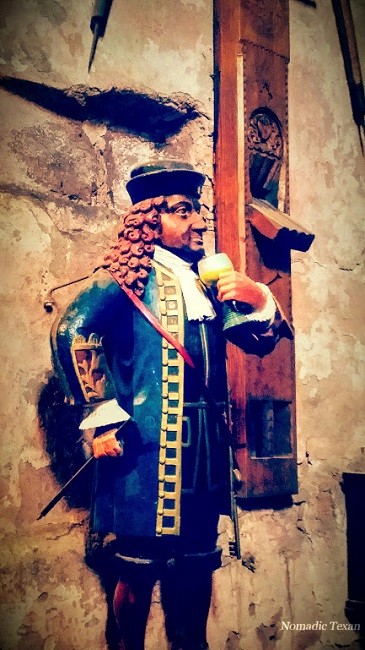
Perkeo Court Jester at the Heidelberg Castle
After we left the castle we toured Old Town and were released to walk on our own for a brief period. In the middle of Old Town is their beautiful Church of the Holy Spirit. A gorgeous sanctuary completed in 1426 while the Spire was finished in 1439. The famous Palatine Library, “Bibloteca Palatina” originated and was retained in the gallery of the church, where light was appropriate for extensive reading. Maximillian I, Elector of Bavaria took the entire collection of manuscripts and books and gave them to the Pope during the 30 years war between 1618-1648. Only 885 were returned of the original 5,000 books and 3,524 manuscripts.
The remainder of the books stayed at the Vatican Library in the Bibliotheca Palatina section. During the University of Heidelberg Jubilee several of these books were temporarily returned and placed on display. In the beginning the Church was was used by Catholics and Protestants and even at the same time. A wall was erected in 1706 to separate the two congregations until 1936 when the wall was removed and the church became exclusively Protestant.
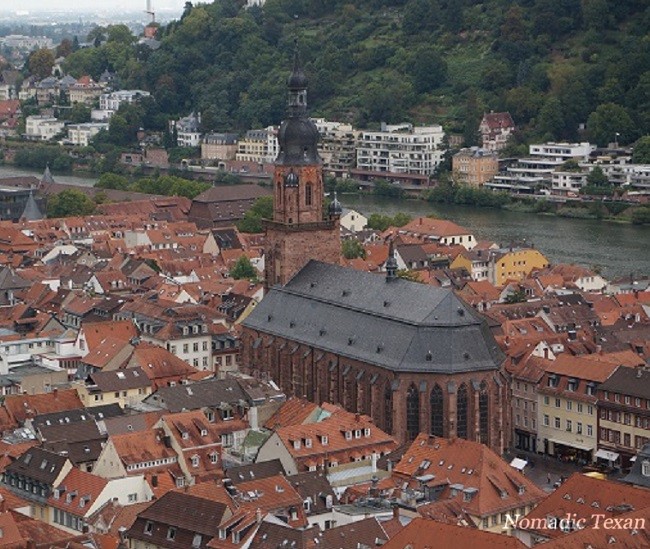
Church of the Holy Spirit
A block or two away from the church was Sofiestrabe street which leads to the Old Bridge. The overpass has been destroyed and rebuilt at least eight times since it was constructed as Roman wood pile bridge in the first century. In the second century a stone bridge was erected by the Romans and eventually collapsed. It was over a thousand years before in 1284 a written mention of another bridge was stated. The first five bridges all collapsed when hit by ice flows in 1288, 1308, 1340, 1400 and 1470.
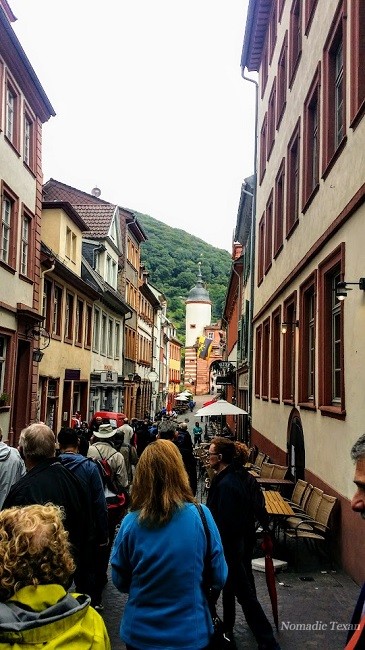
Heidelberg Street Going to the Old Bridge Gate
There are no renderings of these initial five bridges, but there are of the 6th bridge which had a wooden covered wooden roadway that was open at the sides. There is a much more detailed illustration in Sebastian Munster’s Cosmographia of 1550. In the Heidelberg Panorama a bridge on eight stone pillars is evident. The two towers of the bridge gate can be made out at the southern end of the bridge and the monkey tower is on the seventh pillar, towards the north end of the bridge. Had to capture this moment with a photo of Kim in front of the Old Bridge Gate.
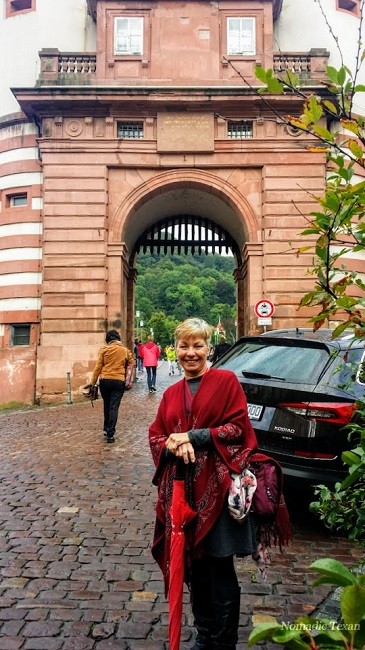
Kim at the Old Bridge Gate in Heidelberg
The “Cosmographia” was one of the most successful and popular books of the 16th century. It encompassed 24 editions in 100 years. This accomplishment was a result of extraordinary woodcuts by Hans Holbein the Younger, Urs Graf, Hans Rudoplh Manuel Deutsch and David Kandel. It was most important in establishing cartography in 16th-century Europe. Among the notable maps within “Cosmographia” is the map “Tabula novarum insularum”, which is credited as the first map to show the American continents as geographically discrete and interprets from Latin as “New board islands”
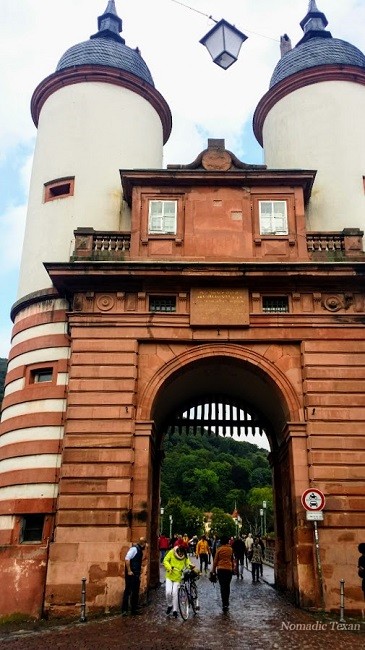
Old Bridge Gate in Heidelberg
Directly behind the double towered gate on the south end is a statue honoring Karl Theodore who reigned as Prince-Elector and Count Palatine from 1742, as Duke of Julich and Berg from 1742 and also as prince-elector and Duke of Bavaria from 1777 to his death in 1799. He was a member of the House of Palatine-Sulzbach, a branch of the House of Wittelsbach. During his reign he oversaw construction the “Old Bridge” which was completed in 1788. The statute was built by Franz Conrad Linck and the three female figures at the foot of this statue symbolize piety, justice, agriculture and trade.
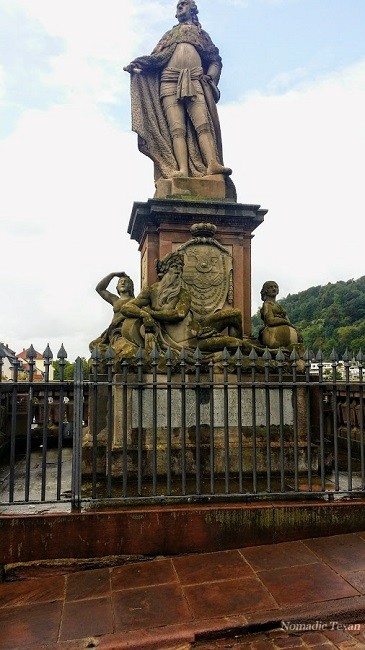
Statue of Karl Theodore on Old Bridge in Heidelberg
Heidelberg City Hall (‘Rathaus’) is located right on Market Square in the backdrop of the historic Old Town, the world-famous Castle ruins and the banks of the river Neckar. It is the focal point for local politics and the nerve center of the city’s governmental services. For citizens of the Old Town, it is also their local municipal main office, the “little city hall”, as it is known. Each neighborhood has one, so locals do not have to travel too far for help and advice.
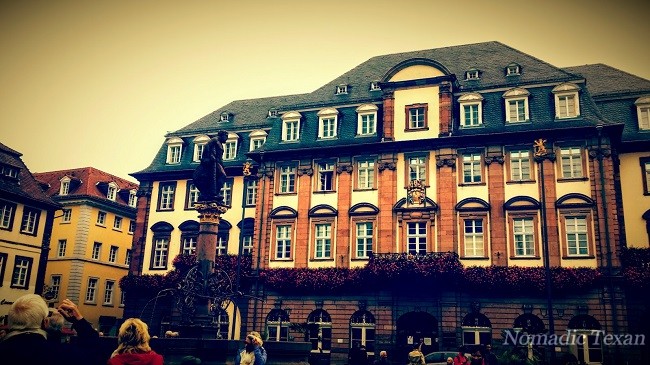
Heideleberg Rathaus City Hall
Cafe Gundel is one of the oldest artisan bakeries in Heidelberg and serves a myriad of cakes, pastries and sweet goods along with seasonal goodies. The perennial goods include rhubarb cake in March, cherry jock (lattice pie) in June, onion cake in September, Easter bunnies and various handmade chocolates at Easter. Sandwiches and breakfast items are also offered in an original house constructed in 1720 and run by Christian Gundel a fourth generation owner.
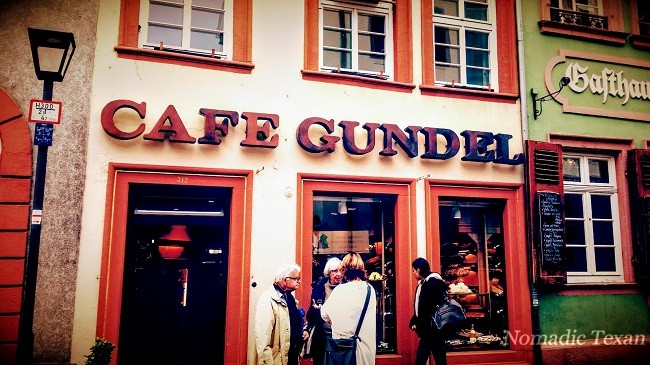
Heidelberg Castle Cafe Gundel
The Cafe Knosel is located across from the Church of the Holy Spirit and is the oldest coffeehouse in Heidleberg. They use a small number of handpicked, regional specialist suppliers on their provider list. This is to ensure that only fresh goods are processed and served on the table. They offer breakfast from 8:00 AM until 11:00 AM and lunch from 11:00 AM until 2:00 PM, serving a wide variety of items priced reasonably for your budget’s sake. Dinner is served until 10:00 PM nightly. The menu includes a myriad of desserts along with an extensive presentation of beer and wines.
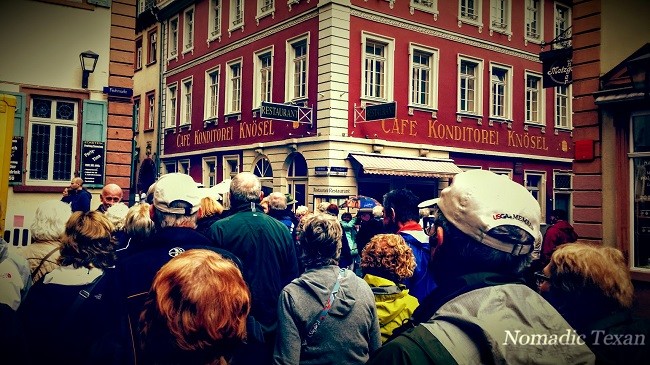
Heidelberg Cafe Knosel Oldest Cafe in the City
I cannot go to Europe without treating Kim and myself to Gelato. It’s a little bit of heaven in my opinion. Even though our traditional US ice cream is laden with butter fat, it’s not the same. In Heidelberg I managed to snap a photo before diving in to my bowl. I have to recommend “That’s Gelato” which has several outlets in Heidelberg area. It was delicious and definitely up to our expectations!
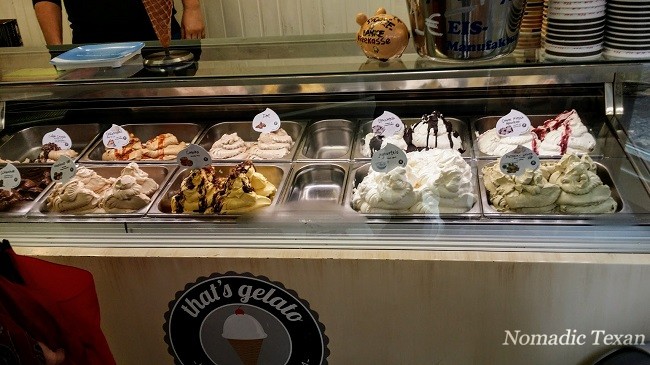
Gelato in Heidelberg Old Town
Our Viking bus dropped us off at this inn to the iron cross on Karlsplatz and then we walked in the direction of Kornmarkt in Heidelberg. Here at the Galthaus zum Eisernen Kruez inn in Heidelberg’s old town on Karlsplatz, we started our city tour of Heidelberg with our guide. We visited several points of interest mentioned above and returned to this spot to catch our bus back to the Viking Longship Eir.
We ended our visit to Heidelberg and began thinking about Strasbourg and Kim and my first visit to France! Little did we know how much we would love their pastries, candy and other sweets. We went crazy! Can’t wait to show you what we bought and ate. I think I gained seven pounds on this cruise and most of it can be attributed to the pastries, cakes and sweets we bought in Strasbourg!
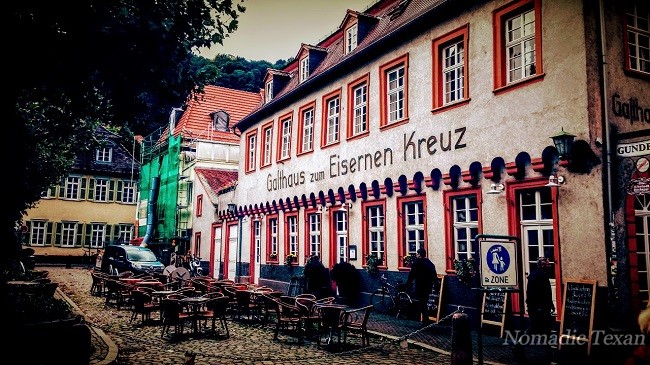
Heidelberg Beer Haus on the Square
***Portions of our cruise were sponsored by Viking River Cruises. All opinions, as always, are those of my own.
